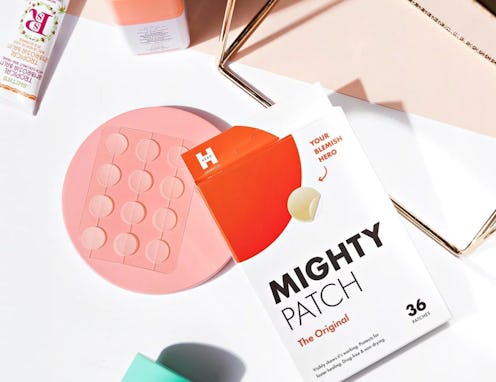(Beauty)
Here's What's *Actually* In Those Trendy Pimple Patches

What the heck is hydrocolloid, and are pimple patch ingredients “clean”? These are the questions that keep me, a woman who theoretically has much better things to think about, up at night.
For those not in the know, pimple patches are those trendy little adhesive dots that magically pull the pus out of pimples overnight. They’re also called “hydrocolloid patches,” since they’re made from hydrocolloid, a material that’s been used as a wound dressing for ages. “The theory is that an acne breakout is a wound,” Ron Robinson, cosmetic chemist and founder of BeautyStat, tells The Zoe Report. “A hydrocolloid patch applied to acne draws out fluid and pus from acne,” Dr. Devika Icecreamwala, M.D., F.A.A.D., a dermatologist with Icecreamwala Dermatology, explains to TZR. “This causes the acne lesion to reduce in size and helps speed up the healing process.”
Love it, sounds great, just one thing: It’s really hard to determine what hydrocolloid actually is. The sites of most of the major pimple patch brands — Hero Cosmetics, Starface, Rael, ZitSticka — list only “hydrocolloid dressing” on the ingredient list, as if hydrocolloid sprouts out of the earth like that. It doesn't; it’s man-made. My question is, with what?
Answers vary based on who you ask. “The material is made of almost any ingredients that form a gel, usually gelatin or carboxymethyl cellulose,” Robinson says. Both substances attract moisture, helping draw fluid up and out of the zit. Dr. Icecreamwala adds pectin (a sugar acid responsible for the texture of jams and jellies, another moisture-attractor) and polymers (essentially, plastics used to form the film-y backing) to the list of possible suspects. Some medical sites cite polyurethane, a rubber-like plastic, as a key ingredient for hydrocolloid dressings, too.
I scoured the internet, and the most complete ingredient listing I could find for hydrocolloid came courtesy of CosRX Acne Pimple Master Patch: It includes cellulose gum, three plastics to form the elastic covering and sticky adhesive, two additional petrochemicals, and a substance called “tetrakis methane,” something that’s not normally used in cosmetics. American Elements, a chemical manufacturer, lists tetrakis methane as a hazardous material that is “fatal if swallowed,” “fatal in contact with skin” and “fatal if inhaled.” Oh, and it “may cause damage to organs through prolonged or repeated exposure.” So… not something I want on my open facial wounds? (Maybe that’s just me.)
Since most brands aren't open about their specific hydrocolloid formulas, there’s no way to know if this CosRX lineup is industry standard — so if you're particular about what you put on your face, it’s best to ask a company's customer service team to supply an ingredient list before purchasing your next pack of pimple patches. It’ll be pretty easy to determine whether the product is “natural,” “clean,” “vegan,” or, um, “not necessarily advisable” based on their feedback.
If the patch is gelatin-based, “I consider this natural,” Robinson says, “because gelatin is derived from natural ingredients.” As a reminder, gelatin is made via “prolonged boiling of skin, cartilage, and bones from animals,” as reported by PopSugar — so it may be natural, but it’s definitely not vegan or cruelty-free.
If you’re looking for something that is vegan and cruelty-free, ask around for cellulose and polymer versions. “However, I wouldn't consider these [types of] patches to be clean or natural, because there is plastic and synthetic ingredients involved,” Salmah Harharah, a holistic skincare consultant with Empowered Skincare, tells The Zoe Report. “A natural alternative would be to apply a spot treatment of pure and raw honey.” (Honey also attracts moisture, and has been used as an antimicrobial wound-healer for centuries. Hospital burn units have it on hand for that very reason.)
If a low-waste or no-waste lifestyle is important to you, then unfortunately, zit stickers probably aren’t in your future. It appears that every option on the market requires plastic, rubber, or petrochemicals in one way or another; either for elasticity or adhesion or both. (“If you have sensitive skin, sometimes that adhesive can be irritating,” adds Dr. Icecreamwala.) Because all three of those materials are perma-pollutants that build up in the environment — not to mention, pimple patches come attached to thin sheets of plastic, which are packaged in another layer of plastic — I’ll be passing on the trend for now. You know, until some genius cosmetic chemist comes up with a sustainable solution. (Looking at you, Robinson.)
That being said, hydrocolloid patches “are not a bad holistic pimple-healing tool, especially when compared to more aggressive pimple treatments like classic acne spot treatments containing salicylic acid and benzoyl peroxide, which tend to dry out the skin,” according to Harharah. “Hydrocolloid pimple patches can be considered to be a truly mild, gentle, and effective way to treat pimples, as long as the user is mindful and aware that they serve as a secondary healing tool; meaning, they do not prevent new pimples from [forming].” Dr. Icecreamwala likes them too, but only for whiteheads. “They do not work well for comedonal acne,” she says.
It's not the answer I wanted, but at least I’ll sleep soundly tonight knowing that hydrocolloid patches don’t fit my personal definition of “clean” or “natural.” I might have a pimple to show for it in the morning — but that’s what honey’s for, right?
This article was originally published on